Chimney for a boiler room: calculation of height and cross-section according to technical standards
The main function that a chimney for a boiler room should perform is to remove flue gases from the boilers into the atmosphere and disperse them in this space. It also has an additional function: they must create natural traction resulting from the difference between the temperature in the furnace and outside.
We will introduce you to the varieties of smoke channels, the classification of which is based on the design features and material of the pipes. Here you will learn how to calculate geometric parameters using a specific example. Our tips will help determine the type and size of the chimney.
The content of the article:
Chimney Types
In large boiler rooms, natural draft cannot provide full combustion, here it is forced to create using smoke pumps. The combustion process and the discharge of its products into the atmosphere should bring as little harm to the environment and not cause emergency situations as a result of pressure in the furnaces exceeding the norm.
Structurally pipes for boiler rooms are very different from each other both in the type of the supporting structure and in the material of manufacture. According to the first sign, several types of pipes are distinguished.
Self-supporting boiler tubes
Such vertical structures are single or multi-barrel. They divert combustion products from boiler rooms and boilers.
They are used regardless of the type of fuel, but subject to certain requirements:
- The temperature of the flue gases passing through the self-supporting pipes should not exceed 350 degrees C.
- Combustion products should not be chemically aggressive.
- The optimum snow load for self-supporting structures is 250 kg per kV. cm, wind - 30 kg per kW. see in the conditions of the II wind region.
A self-supporting pipe is installed on the roof, and fixed inside the building. Its design features provide the possibility of transportation and installation in place, as it consists of separate sections, which are 3-ply sandwich pipes. The structure is attached to the foundation using anchors.
Inside the pipe is a layer made of durable steel, not amenable to the substances released during combustion. The outer layer protects from weathering.

The parameters of smoke structures must comply with the requirements set forth in regulatory documents. Their calculation is based on such factors as the number of boilers, power, type of fuel. The emission standards must be taken into account. In some cases, chimneys are equipped with a platform, a ladder, an inspection hatch, and a light barrier.
Column smoke constructions
This type of pipe consists of an outer shell made of high-carbon steel and internal trunks of different diameters made of stainless steel inserted into it to exhaust gases. The design is fixed in the anchor basket, poured into the foundation. There can be either 1 or several. To prevent condensation from settling inside, use thermal insulation.
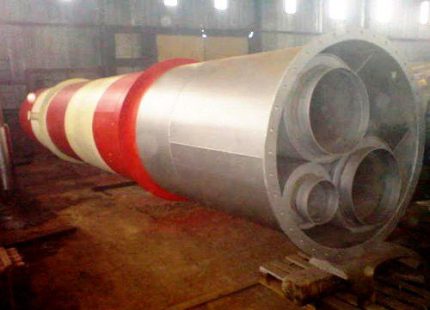
The advantage of this design solution is a long service life, the prospect of connecting several boilers. The thickness of the steel and the brand are chosen, starting from the temperature and aggressiveness of the combustion products.
The diameter of each barrel can reach one and a half meters, and if they plan to use a common gas duct for several boilers, a diameter of about 3 m is necessary. To prevent condensation, the trunks are covered with thermal insulation.
Features of façade and facade chimneys
They install near-front chimneys for boiler houses attached to the house or built-in. Fasten them to the wall of the building using brackets. Chimney components are trunks and a frame or anchor fasteners.
The barrel has 3 layers: inside is stainless steel, then thermal insulation and galvanized steel. Pipes are designed for boiler rooms, where boilers run on gas or liquid fuel.
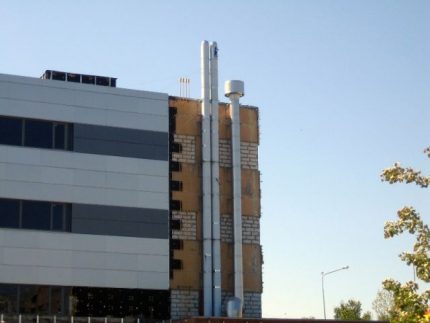
Near-facade and facade pipes transfer the weight load through an additional lower foundation and wind through vibration-damping fasteners. This type of chimney, in terms of material costs, is the most economical due to the lack of load-bearing structures and a solid foundation.
The modular system used to create the vents provides easy replacement of damaged parts.
Truss pipes
Such metal construction consists of pipes fixed on a durable self-supporting truss type column. The farm, in turn, is fixed in an anchor basket, poured into the foundation. Truss chimneys are suitable for use in regions with hazardous seismological conditions.
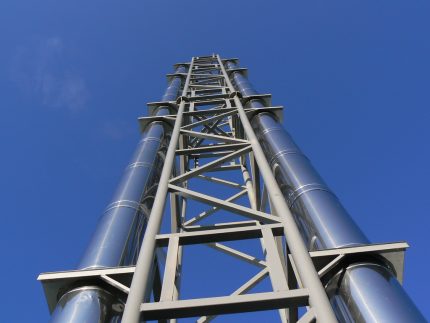
To prevent corrosion, the gas outlets are coated with a primer, then painted.
The trunk for exhaust gases is composed of modules consisting of 3 layers:
- internal contacting directly with the products of combustion and made of stainless steel of special grades;
- 5-6 cm thick, performing the role of thermal insulation;
- external, protecting the insulating layer from the negative effects of the environment.
For anticorrosion coatings, paints containing a large percentage of zinc are used. In some structures inside the column may be stairs and platforms that facilitate maintenance. The structural elements of pipes of this type are relatively lightweight and this facilitates both their transportation and installation work.
Mast chimney pipes
The central element of the mast pipe is a support tower - three or four mast, to which chimneys are attached. All nodes of the structure are assembled on the basis of a concrete pillow, starting from the bottom and gradually moving up. Use a rivet joint during assembly or use self-tapping screws.

Typically, individual elements are transported to the installation site and assembled as a designer. This process takes very little time - a few hours. The chimney can reach a maximum height of 28.5 m. Stability ribs are provided by stiffeners - steel guy wires with a cross section of 1.6 to 2 cm. They compensate for the action of transverse forces.
Materials for the construction of boiler pipes
Smoke exhaust systems are built from various materials - brick, steel, ceramic, polymer. Brick chimney, built over brick stoves and fireplaces, has good mechanical strength, excellent heat capacity, a fairly high degree of fire safety.
The drawbacks of these designs are also many, therefore, in modern construction, completely brick chimneys are becoming less common. Regulatory documents limit the height of brick pipes to 30-70 m, and the diameter of 0.6-8 m.
On the walls of a brick pipe with many protrusions and recesses inside, there is always a lot of condensation, soot containing sulfur oxides. The latter, reacting with water, forms acids that actively destroy brick.
Roughnesses of the surface, narrowing of the passage as a result of a gradual increase in the soot layer, cause a decrease in the rate of passage of smoke and tipping traction in the chimney duct.
More resistant to condensation and external factors. ceramic chimneysThey have high fire resistance. But this system has a lot of weight, because inside are metal rods giving it extra strength.This implies the requirements for the mandatory arrangement of a separate foundation, supports, which increases the complexity and cost of installation.
Polymer chimneys are appropriate in boiler rooms with a maximum temperature of 250 degrees C, during installation geysers. They are lightweight, flexible and durable, but are relevant only for gas equipment.
Stainless steel smoke exhaust device - an assembly consisting of individual chimney elements interconnected using fittings: tees, pipes, baffles, tees, taps. Steel chimneys equip mainly gas boilers.
Installation of such a chimney can be performed after the construction of the building in a short time. There is a wide range of fittings, so the pipe can be given any configuration.
The modular chimney can be easily dismantled and moved to another location. An advantage of the design is its low weight, which makes it possible to do without a foundation, resistance to moisture, insignificant deposits of soot on the inner walls, and a high rate of passage of flue gases.
Sanitary standards allow the use of steel pipes for the construction of chimneys with a height of more than 30 m, an exception is possible only when less than 5 tons of multi-ash fuel is consumed per day. The reason is that the service life of such facilities is 10 years, and if high sulfur fuel is used, it is significantly reduced.
Coaxial chimneys are the varieties whose casing is made of steel alloy, we recommend that you familiarize yourself with the structural specifics and operating features of which.
Calculation of pipe parameters
To determine the height and diameter of the chimney for the boiler room, it is necessary to perform an aerodynamic design calculation. The diameter depends on the capacity of individual boilers or the boiler room as a whole.
The burning of fuel and the effective removal of smoke is greatly influenced by draft, which requires a constant supply of air to the furnace. This is ensured both naturally and artificially.
If a smoke pump is built into the system, then the pipe height is not critical. This parameter is important mainly for accounting for harmful emissions into the atmosphere. To determine the self-pull, you need a mandatory calculation of both the height and the cross-section of the pipe.
Determination of pipe height with natural draft
In order to create normal natural draft it is necessary to observe the condition of equal traction and total resistance, which occurs during the movement of flue gases through the gas ducts of the boiler and the path of the chimney. It is possible to provide such a traction provided that the gas resistance is small, when the height of the pipe does not exceed 60 m.
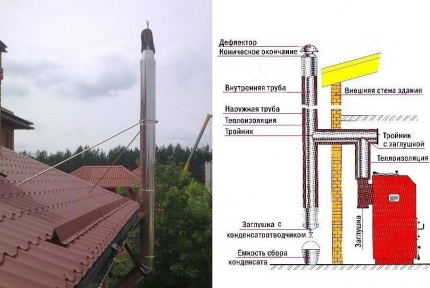
Normative documents regulating the location and calculation of chimneys in height are SNiP41-01-2003, SP 7.13130.2009.
It should also take into account the recommendations set out in the instructions for the boiler, in particular, their following requirements:
- From the grate to the top of the pipe should not be less than 5 m.
- The pipe should rise at least 0.5 m above a flat roof without a high fence.
- In relation to the height of the fence and the ridge of the roof, the pipe should exceed their level by 0.5 m if it is within one and a half m from these structures.
- When the chimney is removed from the parapet and the ridge at a distance of 1.5 to 3 m, its upper point should coincide with their level in height.
With an incorrectly calculated chimney height, many problems can arise and the main thing is air turbulence or a wind backwater zone. Strong gusts of wind can extinguish a fire in a firebox.
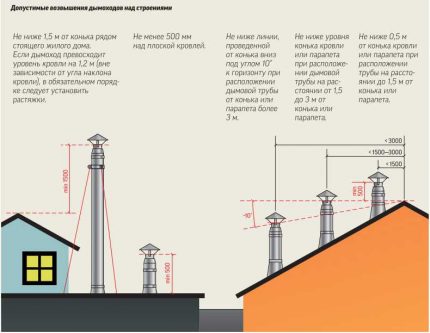
Compliance with fire safety rules is also a prerequisite when designing a boiler room pipe. It is necessary to isolate structures adjacent to the pipe.
To prevent sparks from the ventilation openings on the pipe from falling onto the roof when it is made of combustible material, the height of the structure is increased by 0.5 m. The boiler pipe must be removed from tall buildings and trees by at least 2 m.
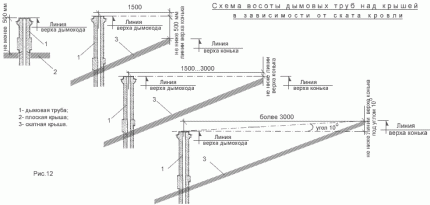
Since the optimum draft arises due to the difference between the total density of gases leaving the chimney and the column of air outside equal in height, the calculation is performed according to the formula:

The calculation is quite complicated, it is better if it is performed by specialists. Parameters affecting the height of the pipe:
- Coefficient A characterizes the meteorological situation in the region.
- Mi is the mass of flue gases that pass through the pipe per unit of time.
- F is the rate at which particles formed during combustion settle.
- Spdki and Sfi - indicators of the concentration of various substances in the flue gas.
- V is the volume of gas.
- T is the difference between the temperatures of the air entering and leaving the pipe.
If boiler room located in the annex to the house, the latter becomes a hindrance. It is necessary that in this case, the head of the pipe should be located above the zone of wind support. Otherwise, the heating equipment will not be able to function normally.
To determine how much the pipe needs to grow, find the highest point on the house, draw a straight angle of 45 degrees with the surface of the earth through it. The space under this line is the area of wind support, and the chimney should be located above it.
Pipe diameter calculation
To calculate the diameter of the pipe, there is a formula:
S = m / (ρr x w),
Here m is the fuel consumption in 1 hour, w is the speed of the flue gases, ρr is the air density under operating conditions, it is determined by the formula: pv = pBnu x 273⁄273 x tos. Where tо is the air temperature outside, pBnu is the air density under normal conditions = 1.2932 kg / m3.
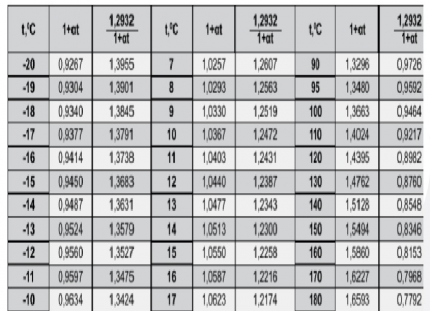
Let 50 kg of solid fuel burn in the boiler per hour, then in a second it will be 50: 3600 = 0.013888 kg. The speed of the flue gas is 2 m per second. At an air temperature of -4 degrees C, the density of air is 0.6881 kg per 1 cubic meter. m. Then S = 0.013888: (0.6881 x 2) = 0.010092 sq. m = 92 sq. see. For round section d = √4 x 92: 3.14 = 10.83 cm.
The diameter of the cylindrical chimney can be calculated by another formula: d = 1000 / 1,163 x (r x Q√H), where r is a coefficient depending on the type of fuel used. For coal it is 0.03, for firewood 0.045, for gas 0.016, liquid fuel - 0.024.
Conclusions and useful video on the topic
A video with a visual demonstration of the process of calculating the height of the smoke channel for equipping a boiler room:
Here, the author of the video shared his own experience in calculating and installing a chimney for a solid fuel boiler:
Another video to help an amateur designer:
It is not so important what fuel the boilers in the boiler room operate on. In any case, one cannot do without a flue gas exhaust system. The main requirements that chimneys must meet are good draft and throughput, environmental standards.
Want to ask a question about a controversial or obscure point that you met while reading the information? Is there any useful information on the topic of the article that you want to share with site visitors? Please write comments in the block below.

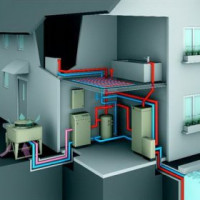 The scheme of the boiler house of a private house: the principle of automation and equipment location
The scheme of the boiler house of a private house: the principle of automation and equipment location 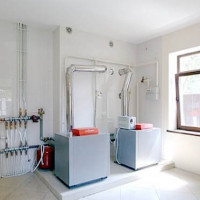 Window for a gas boiler house in a private house: legislative norms for glazing a room
Window for a gas boiler house in a private house: legislative norms for glazing a room 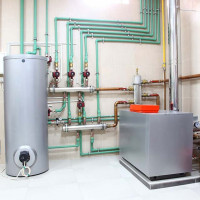 How to equip a boiler room in a private house: design standards and devices
How to equip a boiler room in a private house: design standards and devices 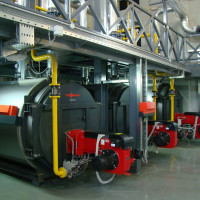 Fire safety requirements for gas boiler rooms: subtleties of arranging rooms for gas boiler rooms
Fire safety requirements for gas boiler rooms: subtleties of arranging rooms for gas boiler rooms 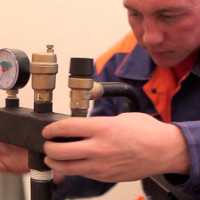 Safety group for heating: device, principle of operation, rules for selection and installation
Safety group for heating: device, principle of operation, rules for selection and installation  Press for fuel briquettes: options for manufacturing installations for pressing sawdust with your own hands
Press for fuel briquettes: options for manufacturing installations for pressing sawdust with your own hands  How much does it cost to connect gas to a private house: the price of organizing gas supply
How much does it cost to connect gas to a private house: the price of organizing gas supply  The best washing machines with dryer: model rating and customer tips
The best washing machines with dryer: model rating and customer tips  What is the color temperature of light and the nuances of choosing the temperature of the lamps to suit your needs
What is the color temperature of light and the nuances of choosing the temperature of the lamps to suit your needs  Replacement of a geyser in an apartment: replacement paperwork + basic norms and requirements
Replacement of a geyser in an apartment: replacement paperwork + basic norms and requirements
We installed a chimney in the bathhouse. The roof is flat, there are no barriers nearby. The height of the pipe above the roof was taken at least 0.5 m. This corresponds to SNiPu, but in reality it turned out that this height was not enough, and the draft was poor. We lengthened the chimney by another 1.5 m and got a wonderful draft. So SNiPs give the minimum permissible sizes, which are mandatory, and technical specifications need to be improved locally.
Strange, of course, the rules you used. Why do you have to rely on them if you can’t make money, and if the next time it is higher than necessary? So, I would advise either to understand it myself, here everything is very easily explained, as for me. Or then already contact the master. Preferably good. Because such rules are like playing roulette.
In this case, the chimney pipe was installed using the “scientific poking method,” as they say. We read that according to SNiP, a minimum height of 0.5 m should be, we understood it literally and made the pipe height half a meter. And the fact that this is the minimum indicator, which is not mandatory, simply can not be lower than the chimney.
It was good that it was possible to grow the pipe to the required height, but for the future it is better to do a preliminary project that will take into account all the technical parameters. Thus, you will calculate the required length of the chimney and there will be no need to redo anything.
It is good that the boiler room was made for a private house, in which case it is not difficult to correct defects. But if you made calculations by self-pull, you would know what height the chimney should be and its design.